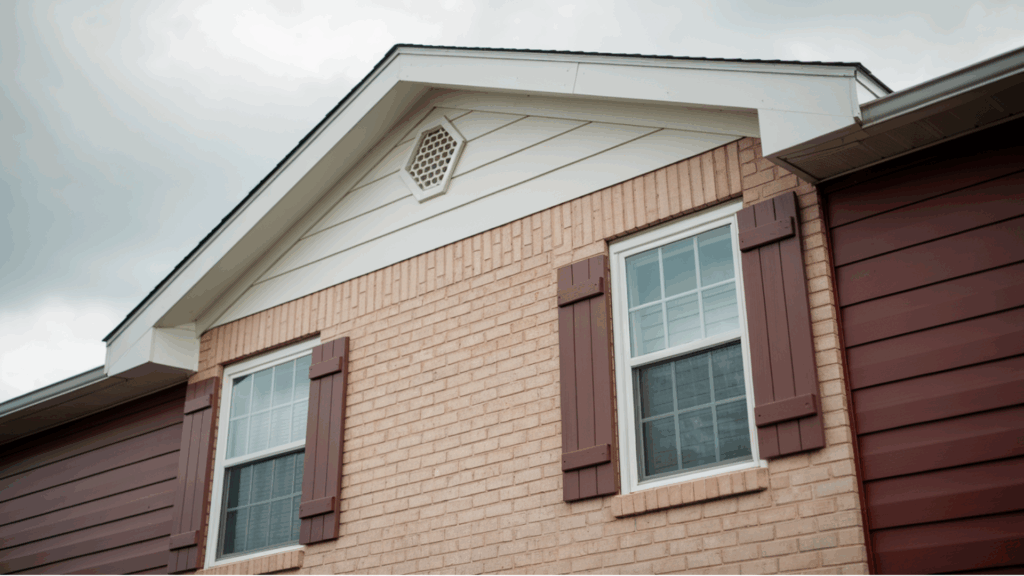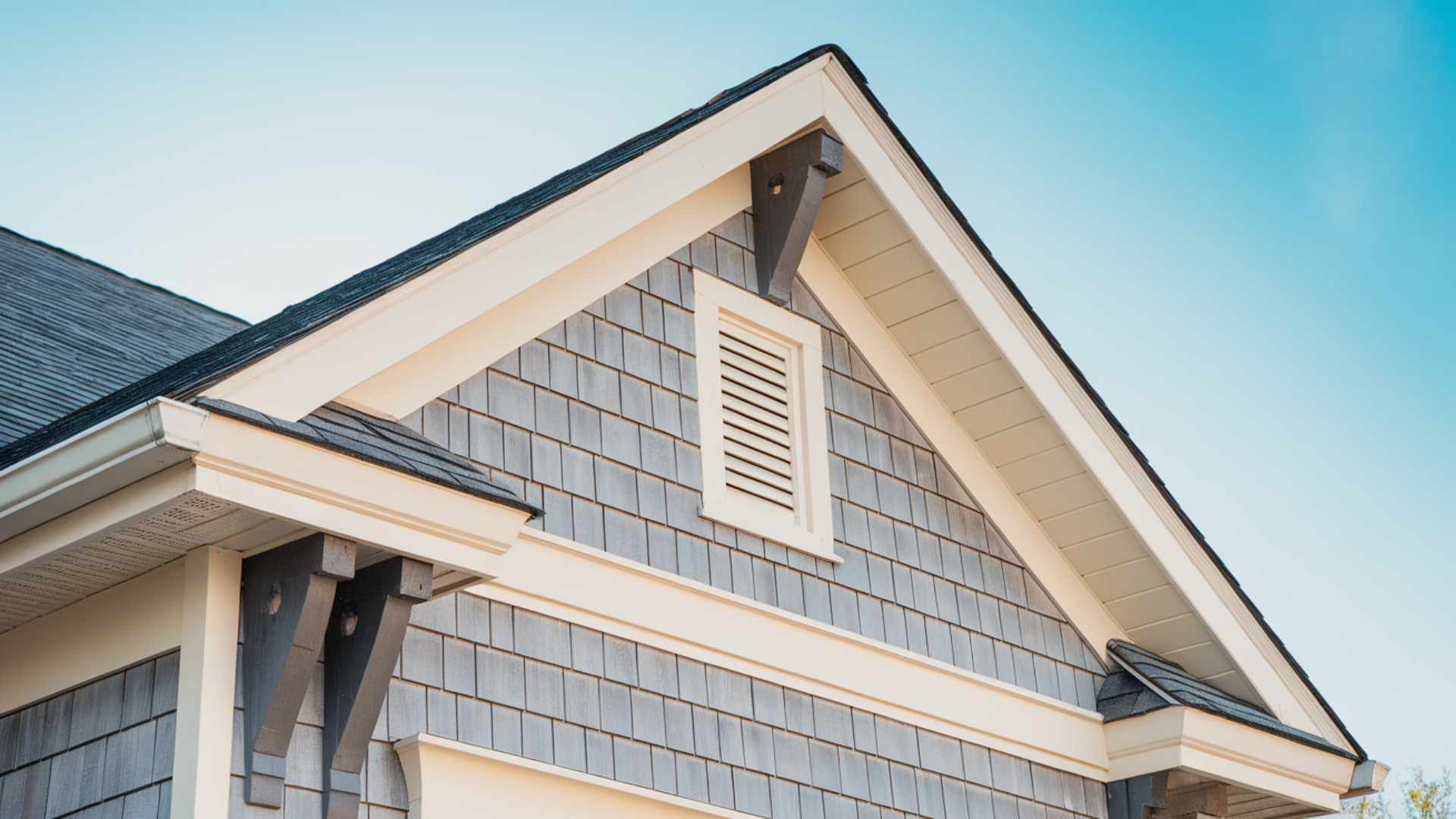Attic ventilation isn’t something most people think about, but it plays a big role in how your home handles heat and moisture.
Without proper airflow, your attic can trap hot air in summer and moisture in winter, leading to higher energy bills, mold, and roof damage. One vent that often gets overlooked is the gable vent.
It might seem small, but it helps your attic “breathe” and can make a real difference in your home’s comfort and upkeep.
In this blog, I’ll cover:
- What a gable vent is
- How it works
- Why it’s important
- How does it compare to ridge vents
If you’re trying to figure out if gable vents are worth having, or even what they do, this article breaks it all down in plain terms. Let’s get into it.
What Is a Gable Vent?
A gable vent is a simple yet effective way to ventilate your attic. Installed high on the exterior wall, usually under the peak of the roof, it allows warm air to escape while drawing in cooler air from outside.
It’s a passive system, requiring no electricity or moving parts, which makes it energy-efficient and low-maintenance.
For best results, it works when paired with another vent on the opposite end, creating airflow.
If you’re seeking an easy, energy-efficient way to keep your attic cool and dry, a gable vent is a solid choice. It may be simple, but it does its job well.
Where Are Gable Vents Located?

The gable end of a roof is where you’ll typically find gable vents, placed high on the wall just under the peak.
Some homes have one vent, while larger attics might need two for better airflow, helping air flow in from one side and out the other.
These vents are easy to spot, often shaped like a half-circle or triangle. They can blend in with the home’s siding or stand out as a design feature.
Once you know what to look for, you’ll start noticing gable vents on many homes around you.
They might not stand out at first, but they play an important role in keeping your attic ventilated.
How Does a Gable Vent Work?
A gable vent works by using natural airflow to move hot, stale, or moist air out of your attic. It doesn’t rely on electricity, just the way air naturally moves in and out of your home.
1. Air Flows in and out Naturally
A gable vent works using natural airflow, no fans or power needed.
When the air outside is cooler than the air inside your attic, it creates movement. One vent pulls in fresh air, and the other lets warm air out.
That cross-ventilation keeps things moving without much effort on your part. I like how simple it is. You don’t have to switch anything on or check wires.
2. Hot Air Escapes and Cool Air Comes In
Warm air rises, and your attic can get really hot, especially in summer.
The gable vent gives that hot air a place to escape. At the same time, cooler outside air flows in through the opposite vent.
This helps prevent your attic from turning into a heat trap. If you’ve ever opened a car door on a hot day, you know the kind of heat I’m talking about.
3. It Cuts Down on Moisture
In colder months, the attic can trap moisture from daily activities like cooking, bathing, or just from air rising.
And that moisture builds up and can lead to mold or wood rot. A gable vent helps let out damp air before it becomes a problem.
You might not see it, but it makes a real difference in keeping your attic dry and your roof in better shape.
Why Gable Vents Are Important?
Gable vents might not seem like a big deal, but they help protect your attic and roof in simple, effective ways. This is why I think they’re worth paying attention to:
1. They Keep the Attic Cooler
One of the main reasons gable vents matter is that they help keep your attic from overheating. On a hot summer day, attic temperatures can climb well over 120°F.
That heat builds up fast, especially in homes without good airflow.
I’ve seen homes where the attic felt like an oven, and that heat can leak into the living space, making your air conditioner work harder.
With gable vents, warm air has a way out, and cooler air can come in.
That small change can help lower your cooling costs and keep your house more comfortable during the hottest months.
2. They Help Prevent Mold
Mold loves warm, damp spaces, and attics are the perfect target if they aren’t properly ventilated.
When air sits still, moisture from inside your home, from things like showers, cooking, and even breathing, can rise into the attic. Without a way to escape, it gets trapped.
That’s when mold starts to grow on the wood, insulation, and even nails. Gable vents give that moisture a path out.
A little airflow from a gable vent can go a long way toward keeping your attic dry and clean.
3. They Can Extend Roof Life
Your roof is a big investment, and keeping it in good shape should be a priority.
Too much heat and moisture in the attic can damage your shingles, warp the wood, and weaken the roofing materials over time.
I’ve seen premature roof failures that could have been avoided with better attic ventilation. Gable vents help by reducing both the temperature and humidity under the roof.
That means less wear and tear, fewer repairs, and possibly delaying the need for a full roof replacement.
If your attic stays cooler and drier, your roof just lasts longer; it’s as simple as that.
4. They Protect Insulation and Wood
Insulation works best when it stays dry. If moisture builds up in your attic, your insulation can get soggy, heavy, and stop doing its job.
That means your home will lose heat in the winter and cool air in the summer. Gable vents help by pulling out moist air before it settles into the insulation or wood framing.
I’ve seen cases where wet insulation had to be pulled out and replaced, something that could’ve been avoided with proper airflow.
Gable vents also help stop wood rot in the attic structure, which can lead to expensive repairs.
5. They Help with Ice Dams in Winter
If you live in a colder area, ice dams can be a serious problem. They form when warm attic air melts snow on the roof, which then refreezes near the edges.
Over time, that ice builds up and can force water under the shingles, leading to leaks and damage.
Gable vents help by keeping the attic closer to the outdoor temperature. That way, the snow stays frozen and doesn’t melt unevenly.
I’ve heard from people who added gable vents and noticed fewer issues with ice after just one winter. It’s a simple fix that helps prevent one of winter’s bigger headaches.
Gable Vents vs. Ridge Vents: Which Is Better?
Gable vents and ridge vents both improve attic ventilation, but work differently. I’ve seen homes that benefit from either, or even both. This comparison will help you choose the best option for your home.
| Feature | Gable Vents | Ridge Vents |
|---|---|---|
| Location | Mounted on the gable walls (the triangular ends of the attic) | Installed along the peak (ridge) of the roof |
| Airflow Style | Moves air side-to-side across the attic | Pulls air from soffit vents upward for full-roof airflow |
| Installation | Easier to install, especially on older homes | It can be harder to add to existing roofs |
| Cost | More affordable upfront | It can cost more due to roofing work |
| Looks | Visible from the outside, may or may not match the siding | Blends in with the roof for a cleaner look |
| Best Use | Good for basic ventilation or small attics | Great for full, balanced attic ventilation when paired with soffit vents |
| Can You Use Both? | Yes, using both can improve overall airflow | Yes, if installed correctly with gable vents not working against the ridge airflow |
If you’re not sure which one to go with, I’d say start by looking at what your home already has. In many cases, you can use both for better results. Just make sure they’re working together, not against each other.
Conclusion
Now you know what a gable vent is; it’s a simple vent on the gable wall that helps move air in and out of your attic.
It works without electricity and helps with heat, moisture, and overall airflow. That means fewer problems like mold, high energy bills, or roof damage.
I’ve found that even a small fix like cleaning or adding a gable vent can make a big difference.
It’s not the most exciting home update, but it’s a smart one.
If you haven’t looked at your attic ventilation in a while, now’s a good time. You can check your vents yourself, or ask a local pro to take a quick look.
Good airflow keeps your home healthier and your roof in better shape. It’s a simple step that pays off in the long run.

